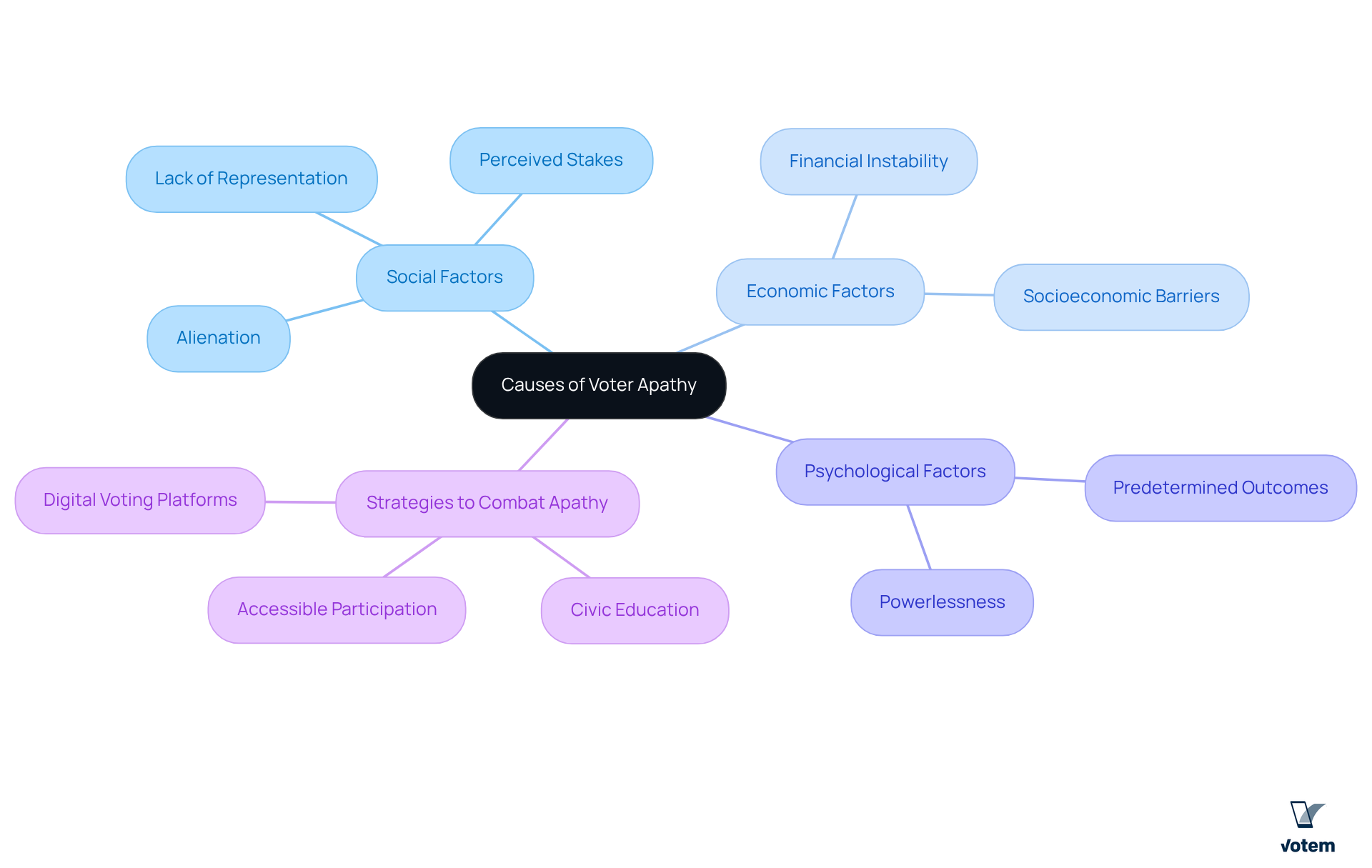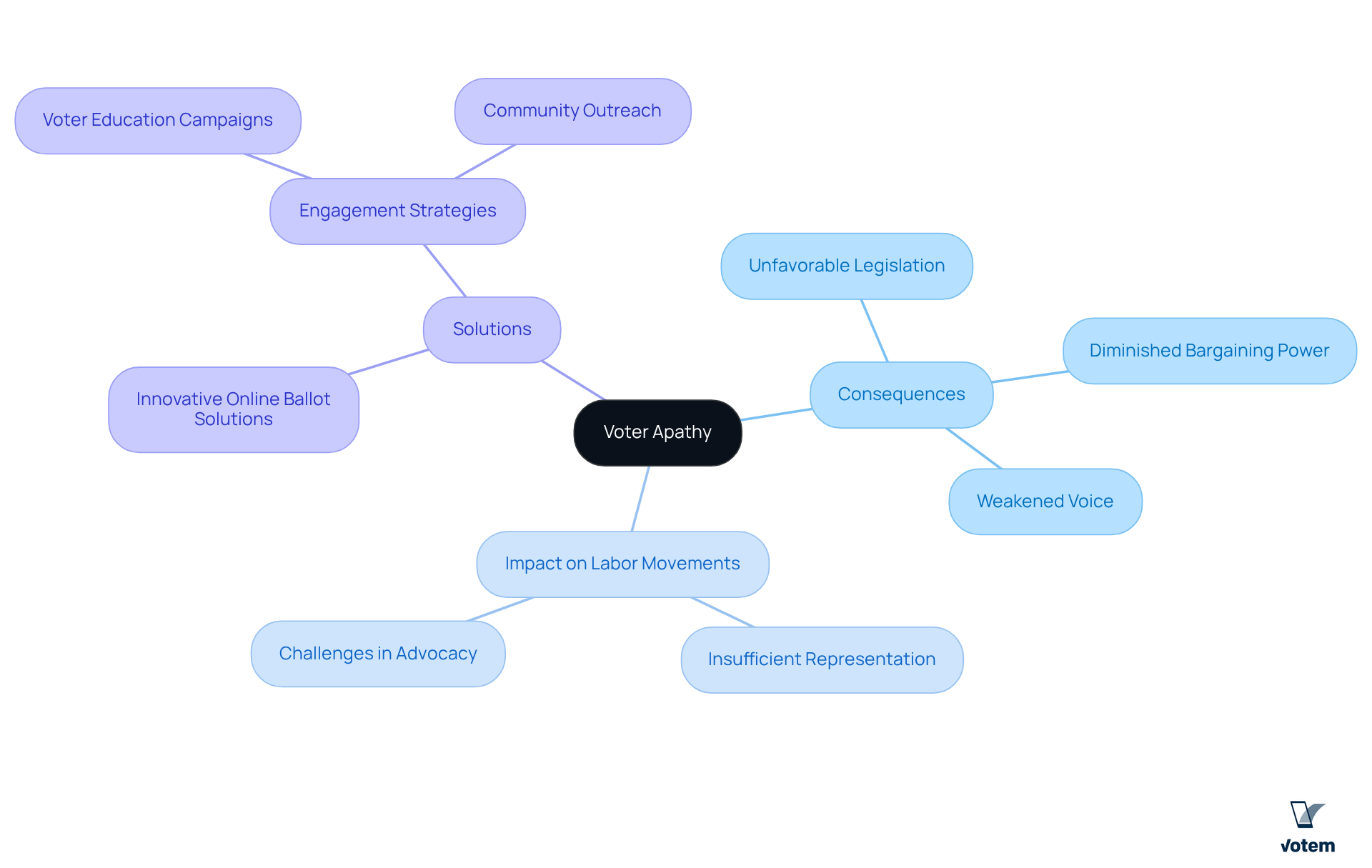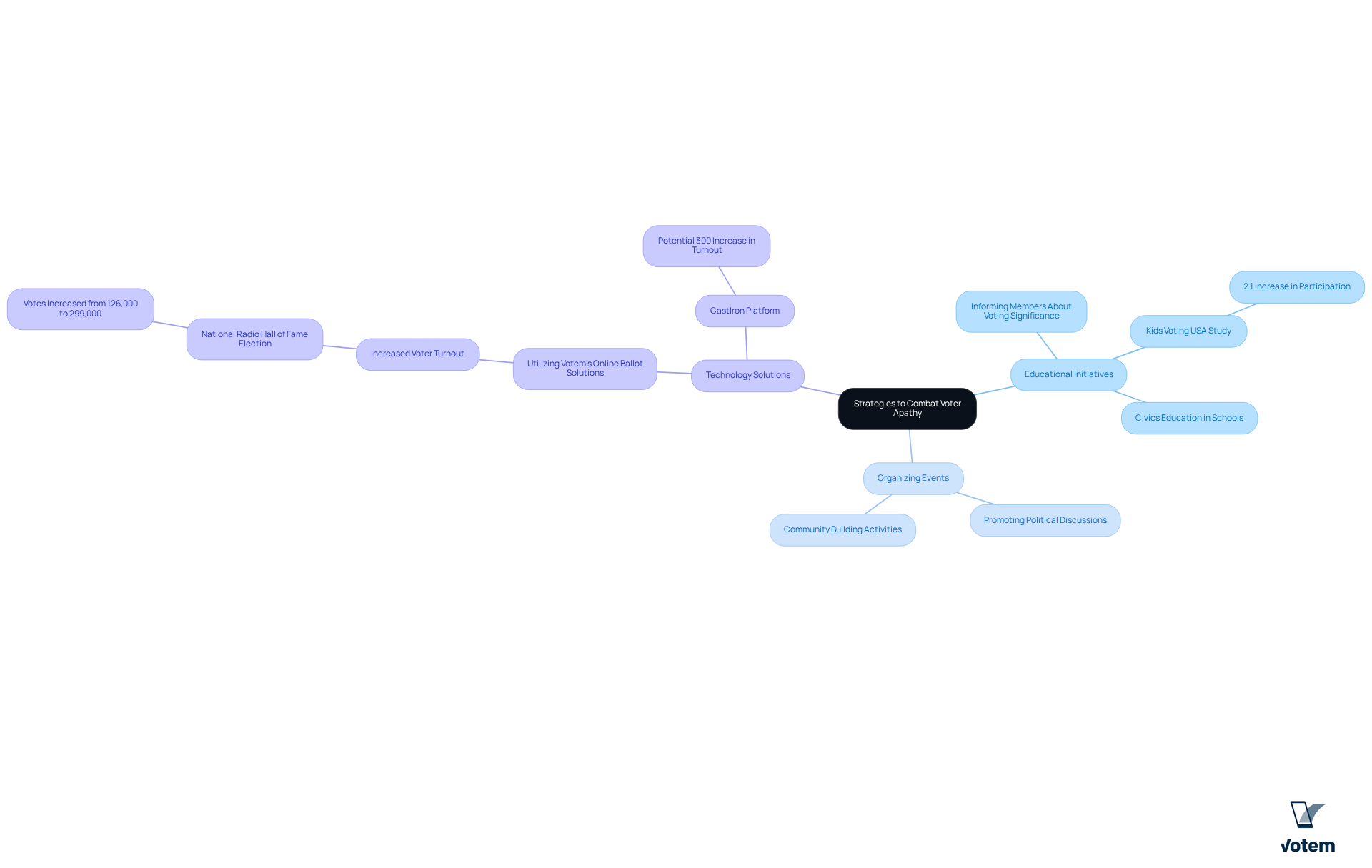Overview
Voter apathy represents a significant challenge characterized by a lack of interest and engagement in the electoral process, resulting in low turnout rates. This phenomenon is particularly detrimental for unions striving to advocate for labor rights. Addressing voter apathy is not merely important; it is crucial for unions, as it directly influences their representation and sway in political decisions that affect workers.
To combat this issue, unions must consider implementing strategies such as:
- Civic education
- Innovative voting solutions aimed at enhancing participation
By engaging members and fostering a culture of involvement, unions can significantly bolster their impact and effectiveness in the political arena.
Introduction
Voter apathy represents a critical challenge within the electoral landscape, marked by a troubling disengagement from the voting process among eligible citizens. This phenomenon not only diminishes the effectiveness of democratic participation but also poses significant implications for labor organizations striving to advocate for workers’ rights.
As unions grapple with the consequences of low turnout rates, a pressing question emerges: how can they effectively combat this pervasive indifference and galvanize their members to engage in the political process?
Understanding the roots and ramifications of voter apathy is essential for fostering a more active and informed electorate. Ultimately, this will strengthen the collective voice of workers in the political arena, paving the way for meaningful change.
Define Voter Apathy: Key Concepts and Importance
What is voter apathy is characterized by a lack of interest, enthusiasm, or involvement among eligible participants in the electoral process, often resulting in low turnout rates. This disengagement raises the question of what is voter apathy, stemming from various factors such as disillusionment with political candidates, the belief that individual votes hold little significance, and a broader sense of detachment from the political system. For organizations, understanding electoral indifference is crucial, as it significantly affects their ability to engage supporters and advocate for labor rights effectively. When association participants exhibit indifference, it undermines the collective strength of the organization and diminishes its influence on political matters that directly impact workers’ rights and conditions.
Statistics reveal that in recent elections, what is voter apathy is highlighted by the fluctuating voter turnout, with only 41% of adult citizens participating in all three of the latest national elections. This underscores the urgent need for organizations to address the issue of what is voter apathy. Additionally, the correlation between educational attainment and electoral participation highlights the importance of organizations engaging in educational initiatives that inform members about the significance of their involvement. By cultivating a culture of engagement and addressing what is voter apathy, unions can enhance their mobilization efforts and ensure their voices resonate in the political arena.
Votem’s innovative online voting solutions have proven effective in improving accessibility and security, as demonstrated by testimonials from satisfied clients. For instance, one testimonial states, ‘Implementing Votem’s new, modern system which allowed greater access for all qualified participants from military personnel to individuals with disabilities was my greatest accomplishment in office.’ Furthermore, Votem successfully managed the receipt of 299,000 votes for the National Radio Hall of Fame, showcasing a substantial increase in participation compared to the previous year’s 126,000 votes. This highlights the potential for technology to enhance turnout rates and engage participants more effectively.
The ranking of the United States at 24th out of 35 OECD nations in electoral turnout highlights what is voter apathy and underscores the need for improved engagement strategies. Organizations like Votem are actively addressing this challenge, providing valuable insights for union leadership.

Examine Causes of Voter Apathy: Social, Economic, and Psychological Factors
To understand what is voter apathy, we must consider the complex interplay of social, economic, and psychological factors. Socially, individuals frequently feel alienated from the political process, particularly when they wonder what is voter apathy due to a perceived lack of representation or effectiveness in their votes. According to the U.S. Census Bureau, data indicates that the less an individual feels they have to lose, the less likely they are to participate in voting. This highlights the significance of perceived stakes in electoral involvement. Economically, financial instability and job insecurity can shift priorities toward immediate survival needs, overshadowing political engagement. Research shows that individuals from lower socioeconomic backgrounds are significantly less likely to vote, facing barriers such as limited access to information and a sense of disenfranchisement. Psychological factors, including feelings of powerlessness and the belief that political outcomes are predetermined, further exacerbate what is voter apathy during elections.
For unions, recognizing these causes is essential for tailoring outreach and mobilization efforts. Strategies to combat electoral apathy include:
- Promoting civic education
- Making participation more accessible through innovative online solutions like those offered by Votem
- Leveraging digital voting platforms to address logistical challenges
Votem’s contemporary system improves accessibility for all eligible participants, including military personnel and individuals with disabilities, which can significantly boost participation rates. As highlighted by Linda McCulloch, implementing Votem’s system was a major achievement, enabling broader access for all eligible participants. Additionally, Votem successfully handled the receipt of 299,000 votes for the National Radio Hall of Fame, demonstrating their effectiveness in increasing voter turnout.
By addressing the specific issues of their participants and implementing these strategies, organizations can cultivate a more engaged voting base and underscore the importance of voting in shaping labor policies.

Impact of Voter Apathy on Unions and Labor Movements
Understanding what is voter apathy is crucial, as it poses significant consequences for organizations and labor movements. When collective participants abstain from elections, they exemplify what is voter apathy, risking insufficient representation in political decisions that directly impact their rights and working conditions. The consequences of this disengagement highlight what is voter apathy, which can lead to unfavorable legislation, diminished bargaining power, and a weakened voice in the political arena. Furthermore, low voter turnout raises concerns about what is voter apathy, which undermines the overall effectiveness of labor organizations and makes it increasingly challenging to advocate for policies that benefit workers. To combat this trend, associations must actively engage their participants, emphasizing the critical importance of casting ballots and understanding what is voter apathy as a means to assert their rights and interests.
Votem’s innovative online ballot solutions enhance accessibility and security, facilitating worker participation in elections, particularly in light of the challenges posed by the Covid-19 pandemic. By fostering a culture of involvement and leveraging modern ballot technologies, labor organizations can amplify their political influence and ensure that workers’ voices are heard in the electoral process. The time for action is now—union leadership must prioritize voter engagement to safeguard the interests of their members and strengthen their collective power.

Strategies to Combat Voter Apathy in Union Contexts
To effectively address what is voter apathy, unions can implement various strategies aimed at enhancing engagement and participation in the electoral process. Educational initiatives play a crucial role in this effort, informing members about the significance of voting and the direct impact elections have on labor rights. A study of Kids Voting USA in Kansas, for instance, demonstrated that participation in elections rose by 2.1 percent among both 18-year-olds and their parents when educational programs were included. Furthermore, evidence indicates that if implemented nationally, same-day registration (SDR) could enhance participation for young individuals aged 18 to 25 by 12 percent, underscoring the importance of educational outreach in this demographic.
In addition, arranging events that promote discussions on political topics relevant to union participants can establish a platform for dialogue and involvement, nurturing a sense of community. Votem’s innovative online ballot solutions exemplify how technology can enhance accessibility and security; their systems have significantly increased voter turnout, as evidenced by the National Radio Hall of Fame election, where votes received surged from 126,000 to 299,000. This illustrates the potential for contemporary voting systems to improve the convenience and security of participation for individuals.
Moreover, creating a robust community among participants through social activities and networking opportunities can foster a sense of belonging and shared purpose. This sense of community is vital, as it motivates individuals to take an active role in the political process. As Franklin D. Roosevelt stated, ‘Voting is an expression of commitment to oneself and society,’ emphasizing the importance of electoral participation. By leveraging these strategies, including Votem’s solutions, unions can effectively address the issue of what is voter apathy and enhance participation rates among their members, recognizing the diverse perspectives that influence their voting behavior.

Conclusion
Voter apathy represents a significant barrier to democratic engagement, characterized by a lack of interest and participation in the electoral process. This disengagement poses a critical challenge for unions and labor movements, undermining their ability to advocate effectively for workers’ rights and influence political outcomes that directly affect their members.
The article delves into various factors contributing to voter apathy, including social alienation, economic instability, and psychological barriers. It highlights alarming statistics surrounding voter turnout, particularly in the context of unions, where the consequences of low participation can lead to diminished bargaining power and unfavorable legislation. Strategies such as promoting civic education, utilizing innovative online voting solutions, and fostering a sense of community among members are essential for combating this trend and enhancing electoral participation.
Ultimately, addressing voter apathy is not just about increasing turnout; it is about empowering individuals to recognize the significance of their votes in shaping labor policies and advocating for their rights. By prioritizing engagement and utilizing modern technologies, unions can strengthen their collective voice and ensure that workers’ interests are represented in the political arena. The time to act is now—encouraging participation is vital for the future of labor movements and the protection of workers’ rights.
Frequently Asked Questions
What is voter apathy?
Voter apathy is characterized by a lack of interest, enthusiasm, or involvement among eligible participants in the electoral process, often resulting in low turnout rates.
What factors contribute to voter apathy?
Voter apathy can stem from various factors, including disillusionment with political candidates, the belief that individual votes hold little significance, and a broader sense of detachment from the political system.
Why is understanding voter apathy important for organizations?
Understanding voter apathy is crucial for organizations as it significantly affects their ability to engage supporters and advocate for labor rights effectively. Indifference among participants undermines the collective strength of the organization and diminishes its influence on political matters that impact workers’ rights and conditions.
What are the statistics regarding voter turnout in recent elections?
In recent elections, only 41% of adult citizens participated in all three of the latest national elections, highlighting the issue of voter apathy.
How does educational attainment relate to electoral participation?
There is a correlation between educational attainment and electoral participation, indicating the importance of organizations engaging in educational initiatives to inform members about the significance of their involvement.
How can organizations address voter apathy?
Organizations can address voter apathy by cultivating a culture of engagement and implementing strategies that enhance mobilization efforts, ensuring their voices resonate in the political arena.
What role does technology play in improving voter turnout?
Technology, such as Votem’s innovative online voting solutions, has proven effective in improving accessibility and security, ultimately enhancing voter turnout and engagement among participants.
What is the significance of Votem’s achievements in voter participation?
Votem successfully managed the receipt of 299,000 votes for the National Radio Hall of Fame, showcasing a substantial increase in participation compared to the previous year’s 126,000 votes, highlighting the potential for technology to engage participants more effectively.
How does the United States rank in electoral turnout compared to other OECD nations?
The United States ranks 24th out of 35 OECD nations in electoral turnout, underscoring the need for improved engagement strategies to combat voter apathy.
List of Sources
- Define Voter Apathy: Key Concepts and Importance
- Voter Apathy Definition, Causes & Effects – Lesson | Study.com (https://study.com/academy/lesson/voter-apathy-definition-statistics-causes.html)
- Voter turnout, 2020-2024 (https://pewresearch.org/politics/2025/06/26/voter-turnout-2020-2024)
- Examine Causes of Voter Apathy: Social, Economic, and Psychological Factors
- Voter Apathy Definition, Causes & Effects – Lesson | Study.com (https://study.com/academy/lesson/voter-apathy-definition-statistics-causes.html)
- 10 Causes of Voter Apathy in the United States | GoodParty.org (https://goodparty.org/blog/article/10-causes-of-voter-apathy)
- Dive into abstentionism: understanding voter apathy (https://eligovoting.com/dive-into-abstentionism-understanding-voter-apathy)
- Impact of Voter Apathy on Unions and Labor Movements
- Increasing Voter Participation in America (https://americanprogress.org/article/increasing-voter-participation-america)
- Unions aren’t just good for workers—they also benefit communities and democracy (https://epi.org/publication/unions-arent-just-good-for-workers-they-also-benefit-communities-and-democracy)
- While Other Voters Moved Away From the Democrats, Union Members Shifted Toward Harris in 2024 (https://americanprogressaction.org/article/while-other-voters-moved-away-from-the-democrats-union-members-shifted-toward-harris-in-2024)
- Strategies to Combat Voter Apathy in Union Contexts
- 7 Strategies to Engage Union Voters Effectively | Online Voting with Votem® (https://votem.com/7-strategies-to-engage-union-voters-effectively)
- Increasing Voter Participation in America (https://americanprogress.org/article/increasing-voter-participation-america)

